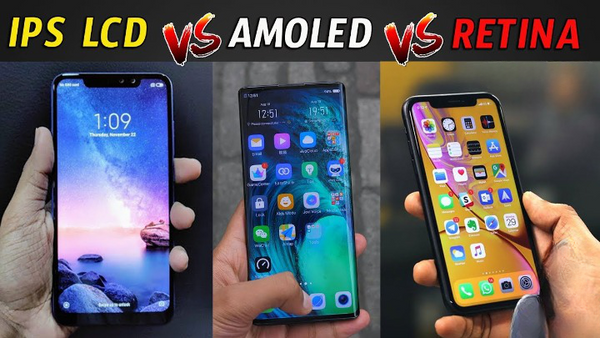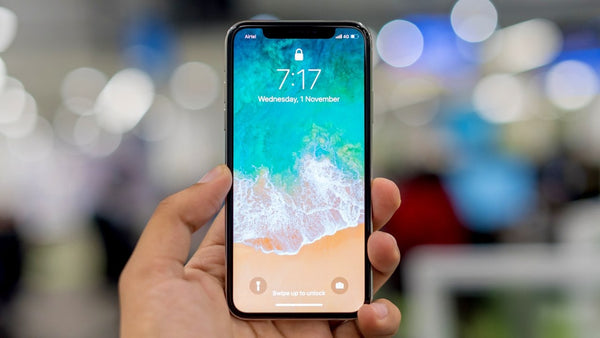In today's mobile-centric world, smartphones have become an indispensable part of our lives. The display of a mobile phone plays a vital role in enhancing the user experience, as it serves as the primary interface between the user and the device. The quality of the display impacts everything from the readability of text and images to the smoothness of video playback. As a result, the display technology used in mobile phones is of utmost importance.
AMOLED displays use organic materials to emit light, resulting in brighter colors, deeper blacks, and better contrast ratios. On the other hand, IPS displays use a backlight to create images, resulting in more accurate colors and wider viewing angles. Retina displays are exclusive to Apple devices and provide a high resolution that makes individual pixels indistinguishable from the human eye.

By comparing and contrasting these three technologies, we hope to provide you with a comprehensive understanding of the different display options available in the market and help you make an informed decision when purchasing a mobile phone. In this blog post, we will briefly overview each technology and compare its features, advantages, and disadvantages to help you choose the best one for your needs.
AMOLED Display
AMOLED (Active Matrix Organic Light Emitting Diode) is a display technology that emits organic materials, resulting in brighter colors, deeper blacks, and better contrast ratios. AMOLED technology is an OLED (Organic Light Emitting Diode) display that utilizes an active matrix of thin-film transistors (TFTs) to control the pixels. Each pixel in an AMOLED display comprises organic phone lcd parts that emit light when an electric current passes through them. This results in a display that can produce brighter colors and deeper blacks than traditional LCDs.
The advantages of AMOLED displays are given below
High contrast ratios: AMOLED displays offer extremely high contrast ratios, resulting in deep blacks and vibrant colors that are more true to life.
Wide color gamut: AMOLED displays typically offer a wider color gamut than other displays, resulting in more vivid and lifelike colors.
Flexible and customizable: AMOLED displays can be made into various shapes and sizes, making them ideal for curved or foldable devices. They can also be customized to display different colors, brightness levels, and resolutions.
Thin and lightweight: AMOLED displays are thin and lightweight, ideal for slim and compact mobile devices.
Fast refresh rates: AMOLED displays have fast refresh rates, resulting in smooth and fluid image transitions and reduced motion blur.

In conclusion, AMOLED screens provide various benefits over conventional LCD screens, such as darker blacks and more vivid colors. There are, however, certain negatives, such as a greater price and the possibility of burn-in. Whether or not a mobile phone with an AMOLED screen is the best option depends on how you typically use your device.
IPS Display
IPS is a display technology that uses a different method for controlling the liquid crystal molecules in the display. This results in wider viewing angles and more accurate color reproduction.
IPS technology is a type of LCD (Liquid Crystal Display) that uses a different method for controlling the liquid crystal molecules in the display. Instead of the typical twisted nematic (TN) technology, IPS displays use a different type of electrode arrangement that allows for more precise control over the alignment of the liquid crystals. This results in wider viewing angles and more accurate color reproduction than traditional TN displays.
Advantages of IPS displays are given below:
Wider viewing angles: IPS displays offer wider viewing angles, making viewing the screen from different angles easier without experiencing color distortion or loss of image quality.
Better color accuracy: IPS displays offer more accurate color reproduction than samsung parts, resulting in more realistic and vibrant images.
Improved contrast ratios: IPS displays typically offer higher contrast ratios than traditional LCDs, resulting in deeper blacks and brighter whites.
Faster response times: IPS displays generally have faster response times than other displays, resulting in smoother and more fluid image transitions.
Lower power consumption: IPS displays consume less power than other displays, resulting in longer battery life for mobile devices.
Better outdoor visibility: IPS displays typically offer better outdoor visibility compared to other types of displays, making them easier to view in bright sunlight or other high-ambient light conditions.
In conclusion, IPS displays are superior to standard TN screens because of their superior viewing angles and color accuracy. Low contrast ratios and slower refresh rates are only two of the drawbacks. Whether or not an IPS display is necessary for a mobile phone depends on how and where you plan to use it.
Retina Display
Retina technology is a display technology developed by Apple that aims to create displays with high pixel density and crisp text. The idea behind Retina displays to make the pixels on the display so small that they cannot be individually distinguished by the human eye at a typical viewing distance.
Advantages of Retina displays are given below:
High pixel density: Retina displays have a high pixel density, resulting in crisp and clear text and images.
Color accuracy: Retina displays offer accurate and vibrant colors, making images and videos more realistic.
Reduced eye strain: Retina displays' high pixel density and clarity can reduce eye strain over extended periods of use.
Anti-glare coatings: Many motorola g play 2021 displays have advanced anti-glare coatings, making them easier to view in bright outdoor environments.
Immersive viewing experience: The combination of high pixel density and color accuracy of Retina displays can result in a more immersive and enjoyable viewing experience.
Enhanced gaming experience: Retina displays' high pixel density, and color accuracy can also improve the gaming experience, making it easier to see and interact with game elements and providing more vibrant and realistic colors.
Sharpness and detail: The high resolution of Retina displays provides a level of sharpness and detail that is difficult to achieve with other displays.

Limited pixelation: The high pixel density of Retina displays minimizes pixelation, resulting in a more seamless and natural-looking image.
Finally, Retina screens are great for reading tiny writing or seeing high-resolution photographs because of their high pixel density and sharp typography. However, you can only get them on a few Apple products, which are more expensive than other forms of screen technology. When deciding whether or not a smartphone with a Retina display is ideal for you, it's important to think about how and why you'll be using the device.
Comparing the Three Display Technologies
Regarding mobile phone displays, three main technologies dominate the market: AMOLED, IPS, and Retina. Each of these technologies has its strengths and weaknesses, and understanding these differences can help you choose the best display for your needs.
To compare these three technologies, let's take a look at some key features:
Contrast Ratio: AMOLED displays have the highest contrast ratio, meaning they can display deeper blacks and brighter whites than IPS or Retina. This creates a more vivid and immersive viewing experience, especially when watching movies or playing games.
Color Accuracy: IPS displays are known for their accurate color reproduction, making them a great choice for tasks that require color precision, such as photo editing. Retina displays also offer excellent color accuracy, but AMOLED displays tend to oversaturate colors, which can be a matter of personal preference.
Pixel Density: Retina displays have the highest pixel density, meaning they can display more detail than IPS or AMOLED displays. This makes for sharper and more detailed images, especially when reading text or viewing photos.
Viewing Angles: IPS displays have wider viewing angles than AMOLED or Retina displays, meaning that you can view the screen from more angles without experiencing color distortion or dimming. This can be especially important if you often share your Xt2163dl with others or use it for presentations.
Durability: AMOLED displays can be more prone to burn-in, occurring when a static image is displayed for too long and permanently imprinted on the screen. IPS and Retina displays don't have this issue. However, AMOLED displays can be more durable in terms of impact resistance because they don't have a backlight layer like IPS displays.
Refresh Rates: AMOLED displays have faster refresh rates than IPS or Retina displays, meaning they can display fast-moving content, such as video games or sports, more smoothly. This can be especially important if you're a heavy user of these types of applications.
Outdoor Visibility: IPS displays perform better than AMOLED or Retina displays in bright sunlight because they can reach higher brightness levels without sacrificing color accuracy. This can make them a better choice if you spend much time outdoors or in bright environments.
Now let's take a look at some real-world examples of how each technology performs in different scenarios:
Watching Videos: AMOLED displays are great for videos due to their high contrast ratio and vivid colors. The deep blacks and bright whites create an immersive viewing experience, which is especially beneficial when watching movies or playing games. However, Retina displays also perform well in this scenario because of their high pixel density and sharpness. While not as vibrant as AMOLED, IPS displays offer a good balance between contrast ratio and color accuracy, making them a solid choice for watching videos.
Browsing the Web: IPS displays are ideal for browsing the web due to their accurate color reproduction and wide viewing angles. When reading text-heavy websites or articles, Retina displays perform exceptionally well due to their high pixel density, allowing for clear and sharp text. While not as ideal for web browsing as IPS displays, AMOLED displays still offer a satisfactory experience with their deep blacks and bright whites.
Gaming: AMOLED displays are perfect for gaming due to their high contrast ratio and vibrant colors. The contrast ratio makes for a more immersive experience, and the vibrant colors enhance the visual impact of games. However, Retina displays can also offer a great gaming experience because of their high pixel density and sharpness. While IPS displays are not as ideal as AMOLED or Retina, they still offer good color accuracy, making them a decent choice for casual gaming.

Outdoor Use: IPS displays perform well under bright sunlight due to their high brightness levels and wide viewing angles. Retina displays also perform well outdoors because of their anti-reflective coating. While not ideal for outdoor use as IPS or Retina displays, AMOLED displays still offer decent visibility in bright sunlight.
Battery Life: IPS displays are more power-efficient than Amoled or Retina displays, which can help extend your phone's battery life. This is because AMOLED displays can selectively turn off pixels to display deep blacks, whereas IPS and Retina displays have to keep all pixels lit up to display colors. However, this can vary based on usage and other factors, such as screen brightness.
Finally, when choosing the best display technology for your needs, there are a few things to consider:
Battery Life: IPS displays are more power-efficient than Amoled or Retina displays, which can help extend your phone's battery life.
Price: AMOLED displays are more expensive than IPS or Retina displays, which could be a consideration if you're on a budget.
Personal Preference: Ultimately, the best display technology for you depends on your preferences and the tasks you plan to use your phone for. Consider visiting a store and checking out displays to see which looks best.
Conclusion
Based on these factors, we recommend AMOLED displays for users prioritizing video watching, gaming, and moderate battery life. IPS displays are ideal for users who prioritize color accuracy and affordability, and Retina displays are best for users who prioritize sharpness and color accuracy.
In conclusion, choosing the best display technology for your needs depends on your preferences and intended use cases. Consider the advantages and disadvantages of each technology, as well as your budget and priorities, to make the best decision for you. For the best displays, please visit mpdmobileparts.com

